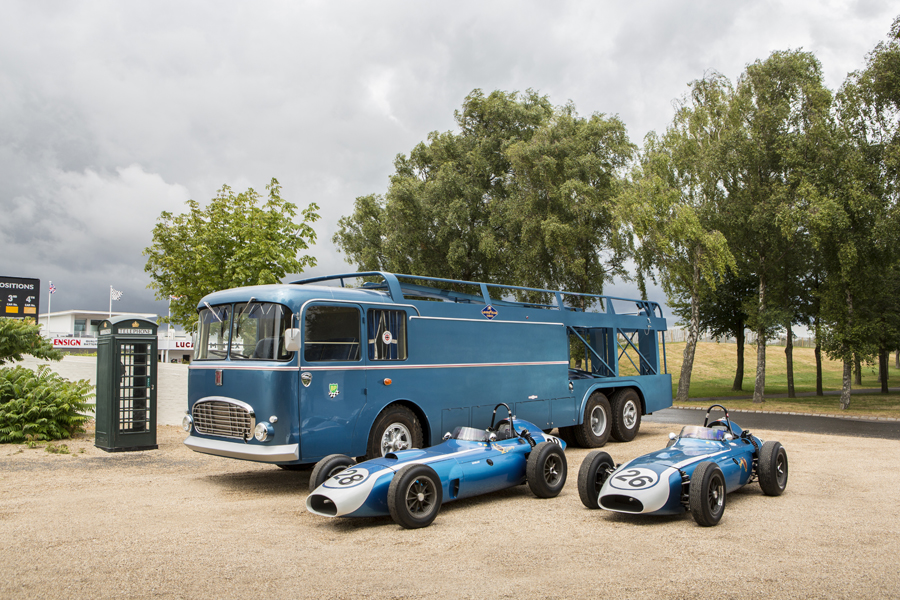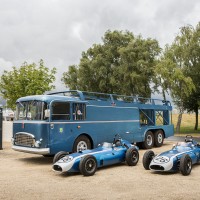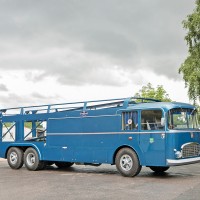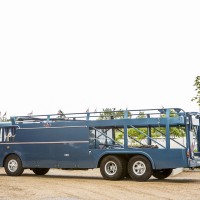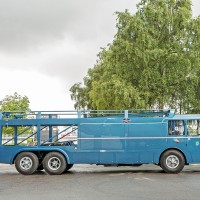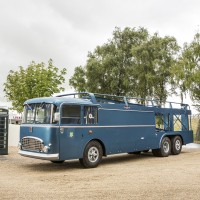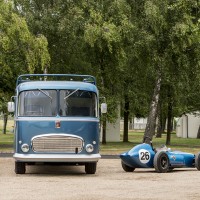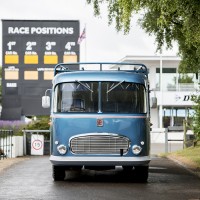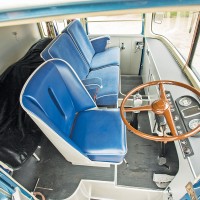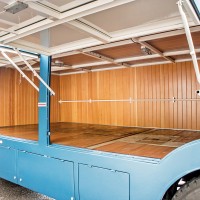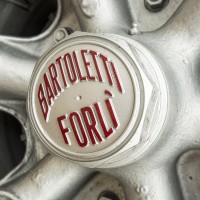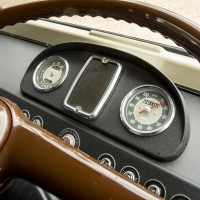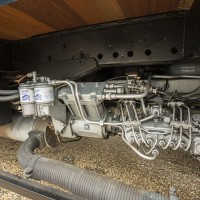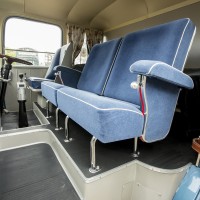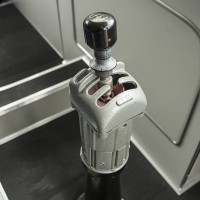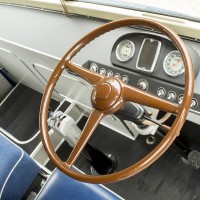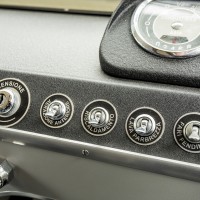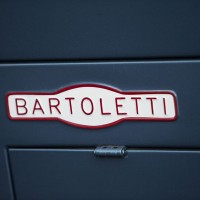SCM Analysis
Detailing
| Vehicle: | 1956 Fiat-Bartoletti Tipo 306 Race Car Transporter |
| Years Produced: | 1956 |
| Number Produced: | One |
| Club Info: | None — unless you count the Historic Grand Prix Cars Association |
| Investment Grade: | B |
This truck, Lot 333, sold for $1,012,824, including buyer’s premium, at Bonhams’ Goodwood Revival sale on September 12, 2015.
As the catalog had it, it is “absolutely dripping with 1950s/60s motor racing history,” which once included taking 11 crew and friends to the opera — which sparked a dispute over how many parking spaces it was liable for.
This was just the coolest thing on wheels at Goodwood, and it will remain so until someone discovers or replicates the long-lost Pegaso “Codfish” vans built from 1952, at least one of which was used to carry race cars.
You have to remember that back in the day, a dedicated race transporter was a rare thing. Race teams might use trucks, or at most, converted buses with doors cut into the back.
Lesser individuals used horse trailers or even massive old Rolls-Royce shooting brakes and hearses, suitably modified for towing.
A long, historic run
The Ecurie Ecosse transporter of 1959 was one of the first custom-designed and -built carriers (see SCM March 2014, “Collecting Thoughts,” p. 30). Even before that, Ferrari pioneered the use of converted Fiat bus chassis to haul three cars, and so did Maserati, which commissioned our subject truck in 1956.
Where they led, others followed, and various Lotus and Mercedes transporters have come out of the woodwork, been restored and pressed into service. Mercedes has even made a replica of its 1954 300S-based Renntransporter, which could carry a single 300SLR at high speed if a replacement was needed urgently at a racetrack.
After Maserati had finished with it, it certainly did the rounds: Reventlow Automobiles Scarab Works team, Shelby American Cobra Works team, Alan Mann Racing, John Woolfe Racing, David Piper Racing, filming “Le Mans,” and the JCB Historic racing team.
Following its massive restoration, it only had 103 miles on the clock, indicating that it had been little used (or the speedo cable was bust) — unlike the Ecurie Ecosse Commer which used to get driven everywhere, usually in the hands of exuberant racer Barrie “Whizzo” Williams, before owner Dick Skipworth sold it in 2013 for a massive $2.7m.
The buyer then also snapped up two of Dick’s team cars, a C-type and a D-type, thereby acquiring a ready-made (and self-contained) collection of the highest pedigree, but that was not the case here, as the Scarab racers this Fiat transporter used to carry, two single-seaters and a copy of the sports racer, were dispersed elsewhere at the same sale.
In fantastic shape
Helping confirm little use, even the floorboards were clean on the underside, and there was no wear to seats or interior. The driver gets a neat little vinyl-trimmed bucket seat, while his two oppos luxuriate alongside on soft velour.
There was one amusing and non-original touch in the interior. During the restoration process, Orosco found on eBay a bed cover and curtains fashioned from fabric featuring three Scarab Grand Prix cars, red, yellow and blue, among other period Formula One models, and he discovered that they had been bought in period from a Woolworth’s store. Scarab founder Lance Reventlow’s mother, Barbara Hutton, had been primary heiress to the Woolworth fortune — and it seems that she had had the design woven into bedspreads for car-mad kids. Orosco bought the fabric for $100 as linings for the cab curtains.
The Leyland diesel engine was a later addition, probably dating back to the Bamford (JCB) days, and it was in good condition, so it was left. The original, smaller Fiat diesel was a bit, er, breathless (rather like the weird Tilling-Stevens supercharged two-stroke opposed-piston, 3-cylinder flat six in the Ecurie Ecosse Commer), allowing only 55 mph and apparently with the replacement unit fitted it would “cruise at 65 all day and it didn’t notice hills.”
The turbo diesel six, a lay-flat design like the original Fiat 203 and probably an 11.1-liter Leyland 0.680 from a Tiger or Leopard bus, drives through a 5-speed semi-automatic, another carry-over from the bus world.
Now, there was little confusion in the catalog, which described it as a 642 and, following the catalog, that’s what we called it last month.But a 642 looks more like a truck. In 2012 RM called it a 306, which is a bus, and this has the same front end. Bonhams didn’t quote a chassis number. When it was cataloged in 2012 it started 3062… but the 306/2 series didn’t appear until 1960.
As used by Maserati and Reventlow it was a four-wheeler, but by the time it’s pictured carrying Daytona Cobras in 1964, it’s fitted, presumably at the behest of Shelby, or possibly for Camoradi, with a tag axle (an extra, undriven axle behind the drive wheels), for extra load capacity, which might be why the original motor struggled a bit.
Orosco said in 2009 (speaking to Automobile, with the odo pictured on 43 miles) that he “had $600,000 in it.”
A big toy for a big boy
This time it was bought for just a tad more by a well-known English restorer and dealer who runs Jaguar Heritage’s racing activities, and the first thing he did was reapply the Cobra livery before displaying it at October’s Classic & Sports Car show at Alexandra Palace in North London, where it was carrying a couple of race Cobras.
This reflects the carrier’s most glamorous and successful period, and because the owner bought it for his private collection, he can do what he likes.
As he told me, “It caused a stir at the Ally Pally. I had a Dinky toy of the truck when I was a boy — I now have the big Dinky.”
The Cobra period makes sense, as to revert to true Scarab-era configuration you’d have to lose that third axle.
Back to hauling race cars
Remaining in the EU meant it was subject to a further 5% import tax and, while the money looks like a lot, it’s in line with the 642 Ferrari transporter sold at Monterey in 2011 for $990,000. The sale price is far lower than the $2.7m paid for the Ecurie Ecosse transporter two years ago.
And while the new owner isn’t exactly hurting for money, realizing a boyhood dream in full size is priceless. He’s one of the few people to have somewhere to store it — and he enjoys access to enough suitable cars with which to accessorize it. So no doubt we’ll be seeing it out at race historic meetings.
Now, taking it to the Mille Miglia would really be something; if you think about the reception it got at Laguna Seca, just imagine what it’ll be like back home in Italy in the middle of the world’s most car-mad nation’s most frenetic historic motoring week. Well bought. ♦
(Introductory text abridged from Bonhams’ exhaustive catalog entry.)
